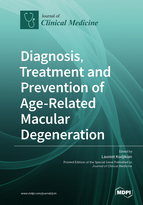Diagnosis, Treatment and Prevention of Age-Related Macular Degeneration
A special issue of Journal of Clinical Medicine (ISSN 2077-0383). This special issue belongs to the section "Ophthalmology".
Deadline for manuscript submissions: closed (20 December 2021) | Viewed by 52684
Special Issue Editor
Interests: medical and surgical retina; laser surgery; uveitis; ocular inflammation
Special Issues, Collections and Topics in MDPI journals
Special Issue Information
Dear Colleagues,
Age-related macular degeneration (AMD or ARMD) is an aging-related ocular disease that can be responsible for severe loss of visual acuity and loss of autonomy in patients. It is a disease that is widespread throughout the world, the incidence of which is decreasing due to the hygienic and dietary precautions adopted by patients, but the prevalence of which is increasing as the population ages.
Ophthalmology has seen the emergence of major technological innovations in recent years, particularly in terms of imaging. They now allow very early and extremely precise diagnoses. These advances also apply to earlier screening, sometimes even at home.
From a therapeutic point of view, the treatment of exudative AMD by intravitreal injection of anti-VEGF has revolutionized the visual functional prognosis since its introduction in 2006. Since this introduction, the frequency of legal blindness in the world has halved. A lot of research work exists on new molecules developed in phase 1, 2 or 3. Atrophic AMD, which can act as a poor relation in the face of wet AMD, fortunately also sees the development of a lot of research axes.
Prof. Dr. Laurent Kodjikian
Guest Editor
Manuscript Submission Information
Manuscripts should be submitted online at www.mdpi.com by registering and logging in to this website. Once you are registered, click here to go to the submission form. Manuscripts can be submitted until the deadline. All submissions that pass pre-check are peer-reviewed. Accepted papers will be published continuously in the journal (as soon as accepted) and will be listed together on the special issue website. Research articles, review articles as well as short communications are invited. For planned papers, a title and short abstract (about 100 words) can be sent to the Editorial Office for announcement on this website.
Submitted manuscripts should not have been published previously, nor be under consideration for publication elsewhere (except conference proceedings papers). All manuscripts are thoroughly refereed through a single-blind peer-review process. A guide for authors and other relevant information for submission of manuscripts is available on the Instructions for Authors page. Journal of Clinical Medicine is an international peer-reviewed open access semimonthly journal published by MDPI.
Please visit the Instructions for Authors page before submitting a manuscript. The Article Processing Charge (APC) for publication in this open access journal is 2600 CHF (Swiss Francs). Submitted papers should be well formatted and use good English. Authors may use MDPI's English editing service prior to publication or during author revisions.
Keywords
- AMD/ARMD
- OCT
- anti-VEGF
- intravitreal injections
- diagnosis
- screening
- oct-angiography
- multimodal imagery
- treatment
- atrophic
- wet/exudative AMD







